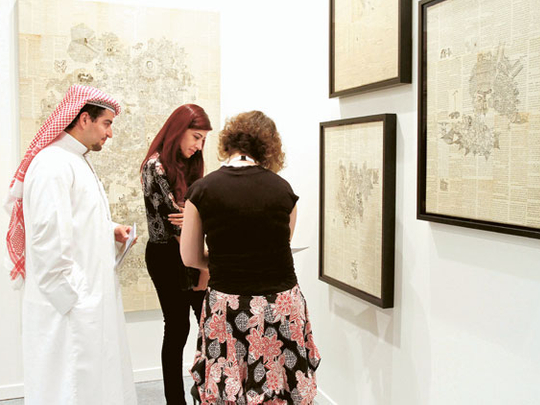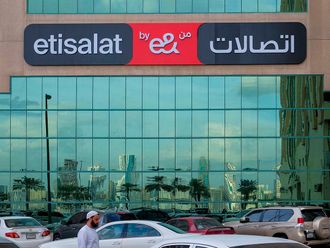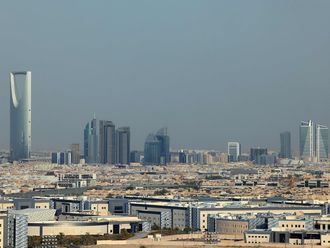
After losing more than 50 per cent of its value during the recent economic downturn, the global art market saw a robust recovery in 2010.
In the last couple of years, the art market has been enjoying a revival as investors begin to realise the importance of art as an alternative investment to diffuse risk. Auction houses around the world are reporting record sales and investors are showing more knowledge and interest in art pieces. As part of this revival, the Middle Eastern art market has also been steadily attracting interest from collectors and investors worldwide.
"Investing in tangible assets such as gold or jewellery has always been very popular in the region. In the recent past, we witnessed a new trend that started at the beginning of the 21st century and accelerated after the 2008 financial crisis: ‘art investing'. The new concept comes from the fact that on top of being an aesthetic pleasure, art can be a financial asset. Indeed in the past 10 years, art has outperformed equity and bonds giving an average return of close to 8 per cent per annum," said Douglas Azar, investment adviser of wealth management at Liechtensteinische Landesbank.
This renewed interest comes hand in hand with a higher demand for Middle Eastern art.
"There is definitely an increased global attention in Middle Eastern art right now. I think part of that is because of what is happening politically but it's also because globally the price of Middle Eastern art is still quite undervalued when compared to other countries. The other thing is the art that comes out of our region is so different from what collectors are used to so it is exciting for them," said Minna Joseph, gallery director at Ayyam Gallery.
Estimates in a Middle Eastern art sales catalogue can begin as low as $1,500 (Dh5,508) and can range up to $20,000 for a prominent piece of work from a promising artist.
"There are people who have invested earlier on in artist communities [and] have seen the price of their work go up dramatically. There was a boom time and increase in prices particularly for Iranian art. There is also a wave of interest in artists who are from the modern school who are being reappraised," said Antonia Carver, fair director of Art Dubai.
Middle Eastern influence is being seen in major galleries across the world. The London Gallery recently did an exhibition, Unveiled, which exhibited new art from the Middle East featuring 21 new artists from Lebanon, Syria, Iraq, Iran and Palestine. The Jameel Gallery of Islamic Art in London's Victoria and Albert museum was also recently opened under the patronage of the Saudi royal family.
According to Michael Jeha, managing director of Christie's Middle East, as the supply of works by the great modern Arab and Iranian masters dwindles, collectors, old and new, are taking an increased interest in the rapidly growing young generation of regional artists.
Another area that is in demand is contemporary artwork from emerging markets in Asia. "China is now becoming the largest auction place in the world before New York and London. This is a major shift which will have a long lasting impact on the art market," said Azar.
Royal patrons
According to Azar, while China and India have a large potential pool of buyers, the Gulf states have just a few collectors, essentially members of the ruling families. "The Qatar ruling family is the largest buyer of contemporary art at the moment. The state is piling up works from artists such as Hirst, Koons, Rothko, and Warhol. They are said to have paid a stunning $250 million for the Card Players by Paul Cezanne — the most expensive artworks ever sold," he said.
When Green Art Gallery first opened in 1995, the majority of their buyers were from the Middle East, but in the last few years their clientele has moved beyond the region and towards Europe and America.
"Collectors today are mature, critical, and do a lot of research on the artworks they add to their collections. It is no longer about art being just decorative; it's definitely on another level," said Aquamarina Adonopoulou of Green Art Gallery.
International auction house Christie's has also noticed the same trend. "Initially collectors mainly bought art from their own country but, through Christie's auctions in Dubai, we started to see the market for modern and contemporary Middle Eastern art become first more regionalised, and subsequently internationalised. So we now see buyers from across the Middle East buying art from neighbouring countries. But we also now see increasing international participation in our sales in Dubai — on average, 30 per cent of the works sold now go to collectors globally," said Jeha.
Dubai's gain
The recent property downturn in Dubai has played its part in strengthening the city's art scene. Sharp drop in rents led to a flurry of new gallery launches. In 2007 only a handful of galleries existed, now Dubai hosts more than 40 galleries. In Al Serkal Avenue alone, the art district in industrial Al Quoz, five galleries are set to be launched this month.
"I have noticed that more and more galleries are opening with a wider range of art from all over the world. Five years ago you pretty much only saw galleries dealing in Iranian and Arab art, but now you have a much more international range which means our market is maturing," said Joseph.
A further growth indicator of Dubai's art is the expansion of her annual Art Dubai event. For four days between March 21 and 24, galleries, artists and investors to flock to Dubai to network, buy and invest.
In its sixth edition this year, the annual event has slowly gained international recognition and has grown to include 74 galleries showing artwork from 31 countries. During the event's inaugural year, it hosted 40 galleries and 7,000 visitors. Last year, visitor numbers jumped to 20,000.
"Over the past decade, Dubai has become known as an international art hub. This growth has been organic with a scene characterised by enthusiastic, enquiring audiences and dedicated local patrons. Art Dubai is both a catalyst in this development and illustrative of it," said Carver.
During the event, international curators, collectors and institutions visit the fair to look at the work available and get familiarised with the local galleries.
"A lot of people who are starting to invest and looking to start a collection might buy one or two works. It's interesting how people can convert from being a casual visitor to being more active. Art collecting is not something that is seen as exclusive anymore," Carver said.
The fair has its roots in the Middle East however, on the back of increased interest from East Asian art dealers and collectors, Art Dubai will be reaching out to China, Korea and Singapore with a focus on art from Indonesia.
Sales surge
Auction houses are also doing well in Dubai. Christie's which was the first international auction house to have a permanent presence in the region, providing an international platform for artists of the region has sold just under $219 million of art, watches and jewellery in the Middle East since its first auction in 2006.
Since then, sales in Dubai have seen on average a 20 per cent rise on new sale registrants every season.
"There is a huge appetite for art in the Middle East. Last year we sold more than 250 works by Middle Eastern and Turkish artists and among these set 85 new world auction records," Jeha said.
Banks have also taken notice of this increased interest. Emirates NBD recently introduced an art investment fund and offers art advisory services for clients with a minimum of $3 million in net worth. This was followed by similar initiatives from other wealth managers in the region, including JPMorgan Chase and Deutsche Bank.
Art funds
Art funds are set up as PE equity funds with holding period of between 5 to 10 years. They buy the art in the first three years and then divest in the following years hoping to make some profit. They try to achieve a ‘buy low and sell high' strategy. Fees are usually 2 to 3 per cent on the management side and 20 per cent from the performance fee.
They target a return between 15 and 20 per cent per annum with a minimum investment of around a quarter of a million dollars. There are around 20 active art funds globally, down from 50 in 2007.
"The Fine Art Fund which recently teamed up with Emirates NBD is a good example of new initiative taking place in the region to enhance and support the growth of the art market in the region. The Fine Art Fund is in the process of launching a Middle East art fund which will focus on acquiring works from the region. Another example can be found in the Osian's Connoisseurs of Art Private Limited [Osian's], which was launched in 2006. The fund was targeting art works from India and the Middle East," Azar said.
According to Azar, the other growing segment is family offices. "Some family offices are setting up art investment vehicles to diversify their portfolio and take advantage of the rising prices," said Azar.
However Azar believes it will be some time before the concept of art as an investment really picks up. "Even if the idea of investing in art to diversify a portfolio is gaining traction as a sound concept, in practice it is only at a very early stage. "The first step I believe is to educate people on "art investment" and give them some guidance on how this new asset class stacks up within the investment universe," Azar said.












